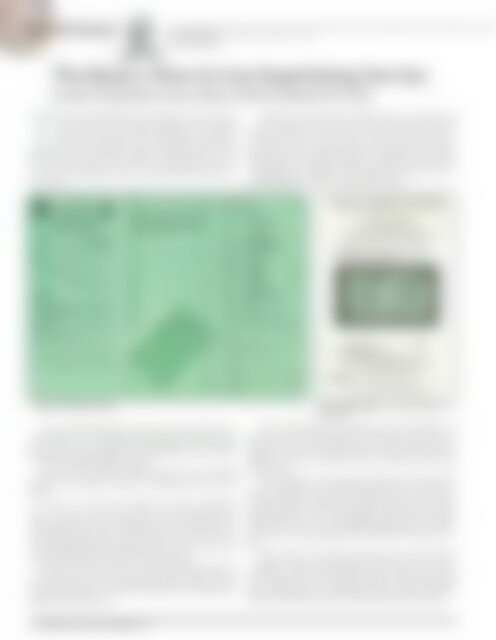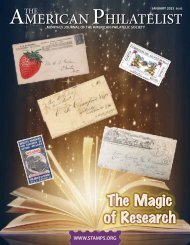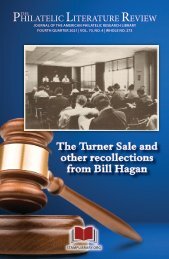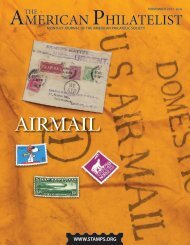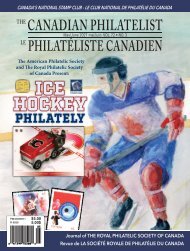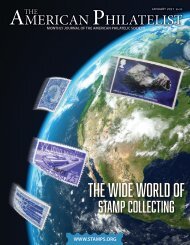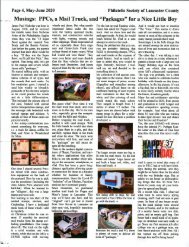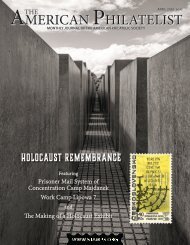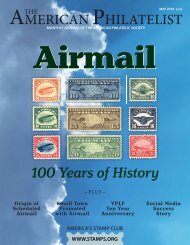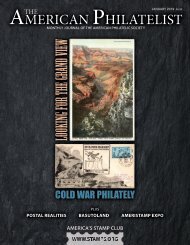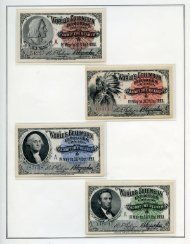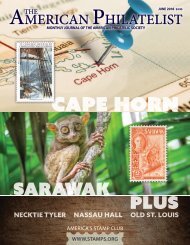February 2018 - Sneak Peek
The American Philatelist is the monthly journal of the American Philatelic Society, the world's largest organization for stamp collectors and enthusiasts. Members receive the printed magazine and can access the digital edition as a benefit of membership in the Society. Please enjoy this sneak peek. We're confident that once you see all that we offer, you'll want to join the APS today.
The American Philatelist is the monthly journal of the American Philatelic Society, the world's largest organization for stamp collectors and enthusiasts. Members receive the printed magazine and can access the digital edition as a benefit of membership in the Society. Please enjoy this sneak peek. We're confident that once you see all that we offer, you'll want to join the APS today.
You also want an ePaper? Increase the reach of your titles
YUMPU automatically turns print PDFs into web optimized ePapers that Google loves.
EXPERTIZING<br />
.........................................................................................................<br />
BY TOM HORN authentication department director<br />
twhorn@stamps.org<br />
The Basics: How to Use Expertizing Service<br />
Society’s Expertizers Issue About 4,500 Certificates Per Year<br />
The American Philatelic Society Expert Service, known<br />
also as APEX, issues 4,500 certificates a year that offer<br />
opinions on the genuineness of philatelic material at a<br />
moderate cost. You might be surprised to learn that the APS<br />
has issued certificates since 1903; an authentication service<br />
was one of the original reasons for the formation of the society<br />
in 1886.<br />
Send the form and item to APEX. How you send it is up<br />
to your tolerance for risk or your stamp insurance policy for<br />
coverage. We take care of it when it is in our system. An image<br />
of the item is scanned and saved when the envelope is<br />
opened and a certification number is assigned. If you include<br />
a self-addressed envelope with postage, we send you an acknowledgement<br />
with the certification number.<br />
A standard APEX application.<br />
Today, APEX utilizes the services of more than 135 specialists<br />
and a variety of high-tech equipment to provide guaranteed<br />
opinions on stamps and other philatelic items in about<br />
175 areas, including dead countries.<br />
But what do you know about this service as it is offered<br />
today? For one thing, it really isn’t complicated. Here are the<br />
basics:<br />
To use our service, you obtain an expert submission<br />
form. You can receive these with a direct request from the<br />
APS or pick them up at our big shows, such as StampShow or<br />
AmeriStamp Expo. Those who need just one form can visit<br />
www.stamps.org/Stamp-Authentication to print a form. You<br />
need to submit every item with a separate form.<br />
Tell us on the form what you want to know about the item<br />
and include the country, catalog number and value and your<br />
contact information. A mount is included for securely attaching<br />
the item to the form.<br />
The final dual-signed APEX certificate for U.S.<br />
Scott 1056.<br />
If we can expertize the item here at our main office, we<br />
do that. If not, the item is placed with others to be sent to an<br />
appropriate expert. When the expert returns the item with an<br />
opinion, we enter the details into the APEX record for that<br />
specific item.<br />
The certificate is then printed, embossed with the APEX<br />
seal and signed by the APEX administrator and APS representative,<br />
which is usually the executive director or the chief<br />
operating officer. This second signature makes the document<br />
official and serves as a proofreading opportunity by another<br />
pair of eyes. We then prepare the certificates and items to return.<br />
The format we use for the information on each certificate<br />
is simple: Country, catalog name and number, used or unused,<br />
back of the stamp condition (gum, no gum, disturbed<br />
gum, original gum, etc.), genuineness, flaws, faults and other<br />
pertinent information that will be placed on the certificate.<br />
160 AMERICAN PHILATELIST / FEBRUARY <strong>2018</strong>


